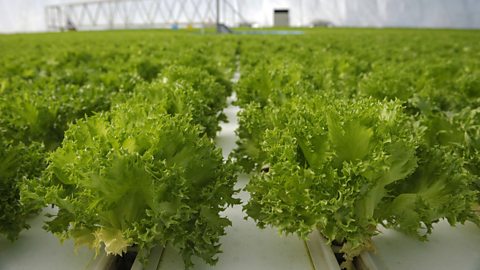Strategies to increase food supply
As the global population continues to increase, countries are finding ways to grow more food.
Irrigation
irrigationThe channelling of water from rivers and streams to fields in order to help crops grow. can double the amount of food produced. Some parts of the world still do not have irrigation systems in place. Only 10% of the food produced in Africa comes from irrigated crops and so there is the potential to improve yieldThe mass of a crop produced. in these countries.
Aeroponics and hydroponics
aeroponicsA system that involves suspending plants in the air and spraying their roots with a fine mist of water and nutrients. and hydroponicsA system that involves growing plants in a porous material (other than soil) and allowing water containing nutrients to filter through it. are systems that allow plants to be grown without soil. Plants grown in this way take in water and nutrients efficiently. These methods are also good for countries where soil erosion or poor quality soil is an issue.
- Aeroponics involves suspending plants in the air and spraying their roots with a fine mist of water and nutrients.
- Hydroponics involves growing plants in a porousSomething that allows water to pass through it. material (other than soil) and allowing water containing nutrients to filter through it.

The New Green Revolution
The Green RevolutionThe application of modern farming techniques, eg fertilisers, high-yield variety (HYV) seeds and irrigation. first began in the 1940s. It refers to the application of modern farming techniques in low income country (LIC)Based on the World Bank's income classifications, a LIC has a gross national income (GNI per capita) of $1,045 or lower., eg fertilisers and pesticides, irrigation and high-yield crop varieties. From the 1960s to 1990s, yields of rice and wheat in Asia doubled. Many LICs could still benefit from the Green Revolution.
The New Green Revolution involves using different seeds to help specific areas that are experiencing the impact of global warming, such as drought and flooding. There is also a focus on improving the nutritional value of crops, rather than just providing more calories. The New Green Revolution should help the poorest areas of the world.
Biotechnology and appropriate technology
Biotechnology is the selective breedingAn artificial process in which organisms with desired characteristics are chosen as parents for the next generation. or genetically modifiedDescribes a cell or organism that has had its genetic code altered by adding a gene from another organism. (GM) of plants and animals to produce specific traits. Both involve mixing two species, both of which have beneficial characteristics. Selective breeding has been used on dairy cows to increase milk yields. GM has been used on wheat to produce crops that are disease resistantOpposing something, or fighting against it. Many strains of bacteria have become resistant to types of antibiotics, which means that it is more difficult to kill them..
appropriate technologySimple equipment and technology that the local people are able to use easily and without much cost. involves using suitable machinery and techniques in LICs. Appropriate technology is usually affordable and easy to use - it can improve yields for many communities.